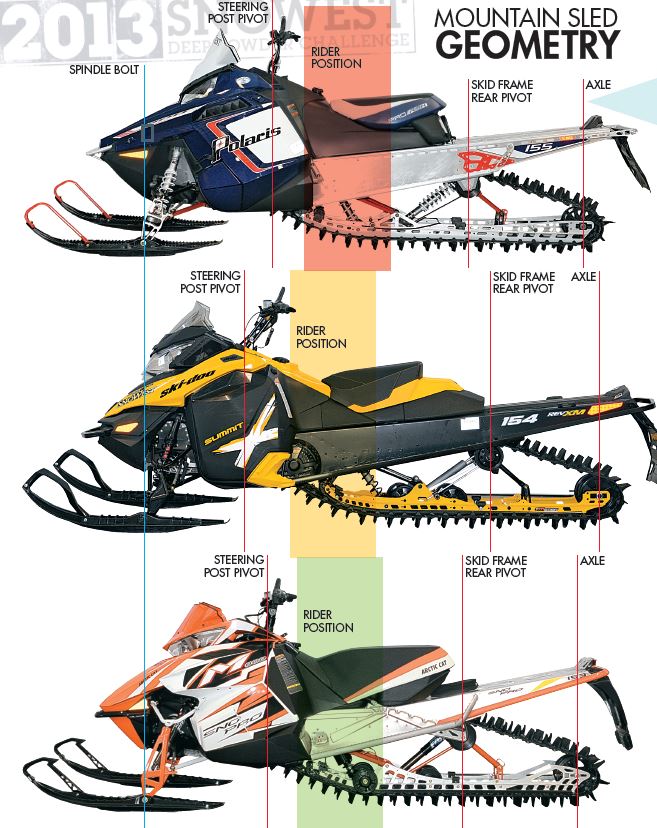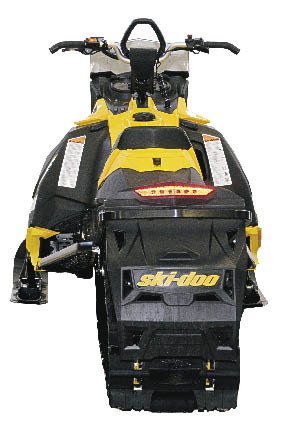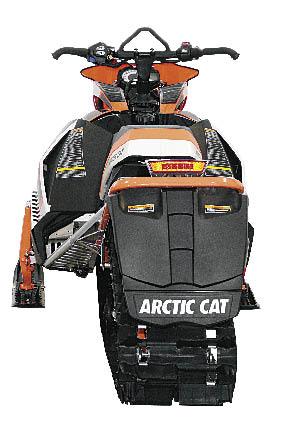
Here is where the rider forward movement has put us. Forward on the sled, body above the steering post, feet close to the driveshaft. This geometry is what lets mountain riders cut extreme sidehill lines through trees without having to sit down, aim and start again.
We lined each of the three 800 test sleds up in the exact same position to see what each sled’s subtle nuances are.
Each sled is lined up on the ski spindle bolt. That’s the reference point, and that’s the spot that matters on the mountain—your body position relative to the spindle.
Polaris Pro RMK 155
.jpeg) The oldest platform becomes the benchmark. The rider’s feet are a little farther back compared to the Cat and Summit, but the rider’s body can get just as far over the front of the sled without the bars interfering. And the true vertical steering post keeps the bars on a fairly level plane when the rider counter steers. The skid’s rear mounting point is forward of the Summit’s but not as far forward as the Cat’s, contributing to its flickable feel. The Pro also has a shallow approach with a very gradual transition angle at the bottom of the rails. That definitely contributes to its ability to get on top of snow and stay there. The Pro has the lowest-profile seat of the group. It’s interesting to note that all three sleds’ handlebars are about the same height from the footboards, yet look how each sled’s cowling is designed differently and how much lower the Pro and Summit’s cowlings are compared to the M. The Pro has the lowest cg feel and it’s easy to extrapolate why.
The oldest platform becomes the benchmark. The rider’s feet are a little farther back compared to the Cat and Summit, but the rider’s body can get just as far over the front of the sled without the bars interfering. And the true vertical steering post keeps the bars on a fairly level plane when the rider counter steers. The skid’s rear mounting point is forward of the Summit’s but not as far forward as the Cat’s, contributing to its flickable feel. The Pro also has a shallow approach with a very gradual transition angle at the bottom of the rails. That definitely contributes to its ability to get on top of snow and stay there. The Pro has the lowest-profile seat of the group. It’s interesting to note that all three sleds’ handlebars are about the same height from the footboards, yet look how each sled’s cowling is designed differently and how much lower the Pro and Summit’s cowlings are compared to the M. The Pro has the lowest cg feel and it’s easy to extrapolate why.
Ski-Doo Summit X 154
 The XM platform did amazing things for the Summit, changing it from the worst sidehilling sled to one of the best ever. The Summit’s rider position is the farthest forward of the three, and the rider’s feet can get significantly farther forward than the other two sleds. However, due to the laid-down steering design (the post under the cowling), the rider’s upper body is restricted in how far forward it can really get. You’ll see studio photos of the sled with the riser block adjusted vertically, but riding like that creates all sorts of ill mannerisms. The riser block must be adjusted inline with the steering post to get this sled to boondock well—which it does. This sled’s skid is mounted further rearward in the chassis, with the rear mounting arm and rear axle noticeably back compared to the Cat and Pro. This makes the sled longer overall. It also makes whipping the nose around on a sidehill 180-degree uphill turn tougher than the other two.
The XM platform did amazing things for the Summit, changing it from the worst sidehilling sled to one of the best ever. The Summit’s rider position is the farthest forward of the three, and the rider’s feet can get significantly farther forward than the other two sleds. However, due to the laid-down steering design (the post under the cowling), the rider’s upper body is restricted in how far forward it can really get. You’ll see studio photos of the sled with the riser block adjusted vertically, but riding like that creates all sorts of ill mannerisms. The riser block must be adjusted inline with the steering post to get this sled to boondock well—which it does. This sled’s skid is mounted further rearward in the chassis, with the rear mounting arm and rear axle noticeably back compared to the Cat and Pro. This makes the sled longer overall. It also makes whipping the nose around on a sidehill 180-degree uphill turn tougher than the other two.
Arctic Cat ProClimb M800 SnoPro 153
 The ProClimb M has the shortest ‘wheelbase’ of the three, with the skid rear arm mount being the closest relative to the spindle. The spindle-to-rear-axle length is also shortest among the three. That adds up to a maneuverable feel in the trees. The rider’s upper body can get over the front end due to the sled’s vertical steering post. The M’s approach angle is not necessarily steep, but deep. The amount of track exposed on the approach is long, and the radius to the rail beam is pretty tight. That can make the sled trench and fight getting back on top of deep snow if it loses plane. But the 2.6 track seems to make up for that. It’s also interesting to note the approach on the three sleds’ nose pans. The M has the steepest and the most narrow nose pan of the three, with the skinniest skis. Also note where the rear of the running boards end on each sled. The M has the shortest boards followed by the Pro and Summit. However, the Summit doesn’t have a brace/foot block. The Cat can definitely dig a deeper trench without hanging up, which gives it a better chance of digging through without getting stuck (or, getting stuck in a deeper hole, depending how you look at it).
The ProClimb M has the shortest ‘wheelbase’ of the three, with the skid rear arm mount being the closest relative to the spindle. The spindle-to-rear-axle length is also shortest among the three. That adds up to a maneuverable feel in the trees. The rider’s upper body can get over the front end due to the sled’s vertical steering post. The M’s approach angle is not necessarily steep, but deep. The amount of track exposed on the approach is long, and the radius to the rail beam is pretty tight. That can make the sled trench and fight getting back on top of deep snow if it loses plane. But the 2.6 track seems to make up for that. It’s also interesting to note the approach on the three sleds’ nose pans. The M has the steepest and the most narrow nose pan of the three, with the skinniest skis. Also note where the rear of the running boards end on each sled. The M has the shortest boards followed by the Pro and Summit. However, the Summit doesn’t have a brace/foot block. The Cat can definitely dig a deeper trench without hanging up, which gives it a better chance of digging through without getting stuck (or, getting stuck in a deeper hole, depending how you look at it).
Dragging Bodies
Again, we lined up each test sled on the same spot at the same angle to compare the side profiles. You can see for yourself how much the body work design plays into sidehilling a sled. The Summit has the narrowest ski stance and the widest track, so that’s a factor. It also has the widest footbed platform measured from outer edges of the running boards at the bottom of the footwells. The M sits second in that measurement, with the Pro having the narrowest measurement. You can see how the Pro is more likely to keep the sled’s body out of the snow on a sidehill where the Summit and M will have more bodywork dragging. One thing we’ve noticed on the M—the tall spindle may increase drag when it’s submerged in the snow on a sidehill, but it provides the best downhill slide control on steep decents with the sled on its side. Pay attention to the running board angles, tunnel taper and rear bumper height on this view, too.